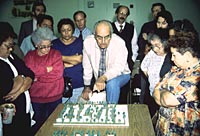|
|
"If you're striving for design excellence, one of the most important stages in the development process is selecting the right project design team. The key is setting the right criteria for evaluating potential team members; including experience with affordable housing, proven design skills, knowledge of construction costs and enthusiasm for your project. The wrong team can derail a good project. The right one will make it happen for you."
Deane Evans,
Sustainable Buildings Industry Council,
Arlington, VA
Tools for Step 9
Resources
Print Step 9
|
|
|
Step 9. Assemble the Right Project Design Team
Why is this step important?
Providing affordable housing is different from most other forms of real estate development. The process typically involves community and resident participation in ways that for-profit developments do not. It can also be highly politicized, especially if NIMBY ("not in my back yard") attitudes are present. Sites can also be problematic. Regulations can be tortuous. And budgets are always too low.
To deal with all these factors and still hold on to and deliver design quality requires a special type of design team:
- one that understands the peculiar constraints of affordable housing development;
- one that has proven that it can work well within these constraints and still deliver design quality;
- one that can work well with, and accept input from, people in the community where the project will be built;
- and, perhaps most important, one that understands costs and how to create quality projects within tight budgets.
Assembling a team with substantial experience in - and a strong commitment to - delivering high quality affordable housing will take a great deal of pressure off the developer, making the entire development process easier and more successful. Not doing so - i.e. assembling a team without adequate experience - can have the opposite effect, putting extra burdens on the developer and potentially jeopardizing both the design and the long term viability of a project.
When should this step be done?
As early in the process as possible, budget permitting, but no later than the first stages of Predevelopment. (See the Design/Development Matrix.)
Special Note: The Design Advisor strongly recommends that any developer obtain professional design assistance as early as possible in the development process (see Step 4). This early assistance is distinct and separate from the services that will be rendered by the project design team. The project team is usually selected later in the development process, may or may not include the same individuals or firms providing early assistance, and is subject to different contracting procedures. Step 9 is focused solely on how to assemble the right project design team. For information on obtaining early professional design assistance see Step 4.
Who should do this step?
The owner/developer with input from the "design committee," if one has been established.
What should be done?
- Select the right architect.
- The design team for a project may include a variety of professionals, including: an architect, a landscape architect, civil and structural, electrical and mechanical engineers.
- In most instances the architect will be the leader, coordinating the activities of the other members of the team and acting as the owner's point of contact.
- Selecting the right architect or architecture firm is therefore the critical step to assembling the right team.
- Print the How to Select the Right Project Architect Guidelines and add them to the Project Book. Use the guidelines, and the accompanying Example Criteria for Selecting an Architect to help guide your selection process.
- Make sure a property manager is part of the design team from the beginning.
- A common problem in affordable housing projects is that key components that impact how the project is operated and maintained are poorly designed or left out altogether.
- Exterior hose bibs are a good, basic example: if you have them, its easy to clean exterior surfaces of the property and water any plantings; if you don't - and they're easy to overlook - it's almost impossible to do these simple tasks. You must either make some other arrangement or, more likely, add them back into the project after the design is substantially complete, creating additional delay and expense.
- Such problems can be avoided if the people ultimately responsible for operating the project - usually the property managers - are brought into the process early as advisors to the design team. In this capacity they can provide periodic reviews of the design to ensure that essential operation and maintenance components are considered and "designed in" from the beginning.
How can doing this help move my project forward?
- Hiring the right design team, with a proven track record in the type of project you are trying to develop, will make all future stages of the development process easier. In addition, the right design team will add immediate credibility to the project.
- Making the property manager part of the team also adds credibility, indicating that the developer understands the value of creating a project that is easy to operate and maintain.
Additional Resources
|
